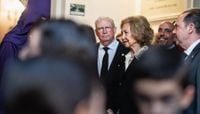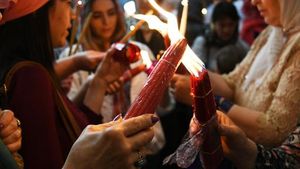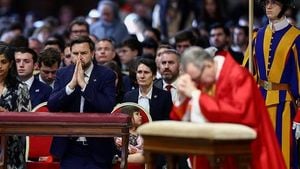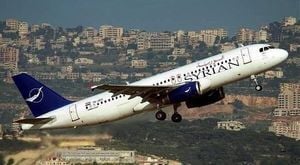Queen Sofía of Spain has made a heartfelt return to Seville to partake in the vibrant traditions of Semana Santa, experiencing the fervor of Holy Thursday and the famed Madrugá for the first time in over 40 years. On April 17, 2025, the 86-year-old royal, who has maintained a deep connection to this religious celebration, visited several historic temples in the Andalusian capital, showcasing her enduring devotion to the cultural and spiritual heritage of Spain.
The visit began at the Parroquia de Santa María Magdalena, where Queen Sofía observed the preparations for the departure of the Hermandad de la Quinta Angustia. Accompanied by Francisco Vélez, the President of the Council of Brotherhoods and Cofradías of Seville, she took a moment to appreciate the artistic heritage of the brotherhood and the solemnity of the occasion. "It was a significant moment for the queen, reflecting her deep interest and respect for the Seville brotherhoods," noted local media.
As the Quinta Angustia began its procession, Queen Sofía was visibly moved, standing at the church’s entrance to witness one of the most revered moments of the night. This participation not only highlights her personal faith but also rekindles memories of her past visits with King Juan Carlos I, who accompanied her during similar events in the 1960s and 1980s.
In 1963, the then-princes Juan Carlos and Sofía attended their first Semana Santa in Seville, witnessing the departure of the Hermandad de El Baratillo from a balcony on Adriano Street. This marked the beginning of a long-standing relationship between the royal family and the city, which has continued to flourish over the decades. By 1984, the entire royal family, including their children, participated in the Madrugá, solidifying their connection to the traditions of Seville.
Following her visit to Santa María Magdalena, Queen Sofía made her way to the sanctuary of Los Gitanos, where she joined the Armaos of La Macarena. This visit was particularly poignant, as the Macarena is one of the most iconic brotherhoods in Seville, known for its deep-rooted traditions and fervent following.
The queen then ventured into the Triana neighborhood, a vibrant area known for its rich cultural history. Here, she prayed before the Cristo de las Tres Caídas and Nuestra Señora de la Esperanza, sharing moments with Sergio Sopeña, the older brother of the Esperanza de Triana. This encounter underscored her ongoing commitment to the religious and cultural practices that are so vital to the community.
As night fell, Queen Sofía arrived at the Basilica de la Macarena to witness the departure of the brotherhood. She presided over the Palquillo of the Council of Brotherhoods in the Plaza de la Campana during the passage of the Gran Poder around 2:30 AM on April 18, 2025. Her presence at this event drew significant attention from both locals and tourists alike, eager to catch a glimpse of the royal who has long been associated with these traditions.
Local media reported that her visit was not only a personal pilgrimage but also a reflection of her desire to reconnect with the popular devotion that characterizes Semana Santa. "She wishes to experience the processions on foot, immersing herself in the celebrations as a common visitor rather than from a privileged viewpoint," remarked social journalist Carmen Enríquez.
In recent years, Queen Sofía has maintained her connection to the Semana Santa festivities, albeit in a more subdued manner. Her attendance at the 2024 procession of the Cristo de Mena in Málaga and her participation in religious events in Mallorca demonstrate her unwavering commitment to these traditions.
Interestingly, this year's visit marks a significant shift in the royal family's approach to Semana Santa. After a period of absence from public religious observances, Queen Sofía's decision to actively engage with the cultural fabric of Spain during such important dates reflects a renewed desire to connect with the people.
The excitement surrounding her presence was palpable, with many locals expressing their delight at seeing the queen back in Seville after such a long absence. Her visit has been described as a return to form, a way to reclaim the royal family's historical ties to the city and its enduring traditions.
As Queen Sofía continues her journey through the heart of Semana Santa, her actions resonate deeply with the citizens of Seville, reminding them of the shared history and cultural identity that bind them to the royal family. This year's celebrations, enriched by her presence, serve as a testament to the enduring power of faith and tradition in Spanish society.
With over 15,000 nazarenos expected to participate in the processions throughout the city, Queen Sofía's engagement with the festivities highlights the unique cultural moment that Semana Santa represents for both the royal family and the people of Seville. As she walks the streets, witnessing the devotion and artistry of the processions, she embodies the spirit of a celebration that transcends generations.
In a world where tradition often clashes with modernity, Queen Sofía's return to Seville for Semana Santa serves as a poignant reminder of the importance of cultural heritage and the deep-rooted connections that define Spanish identity.








